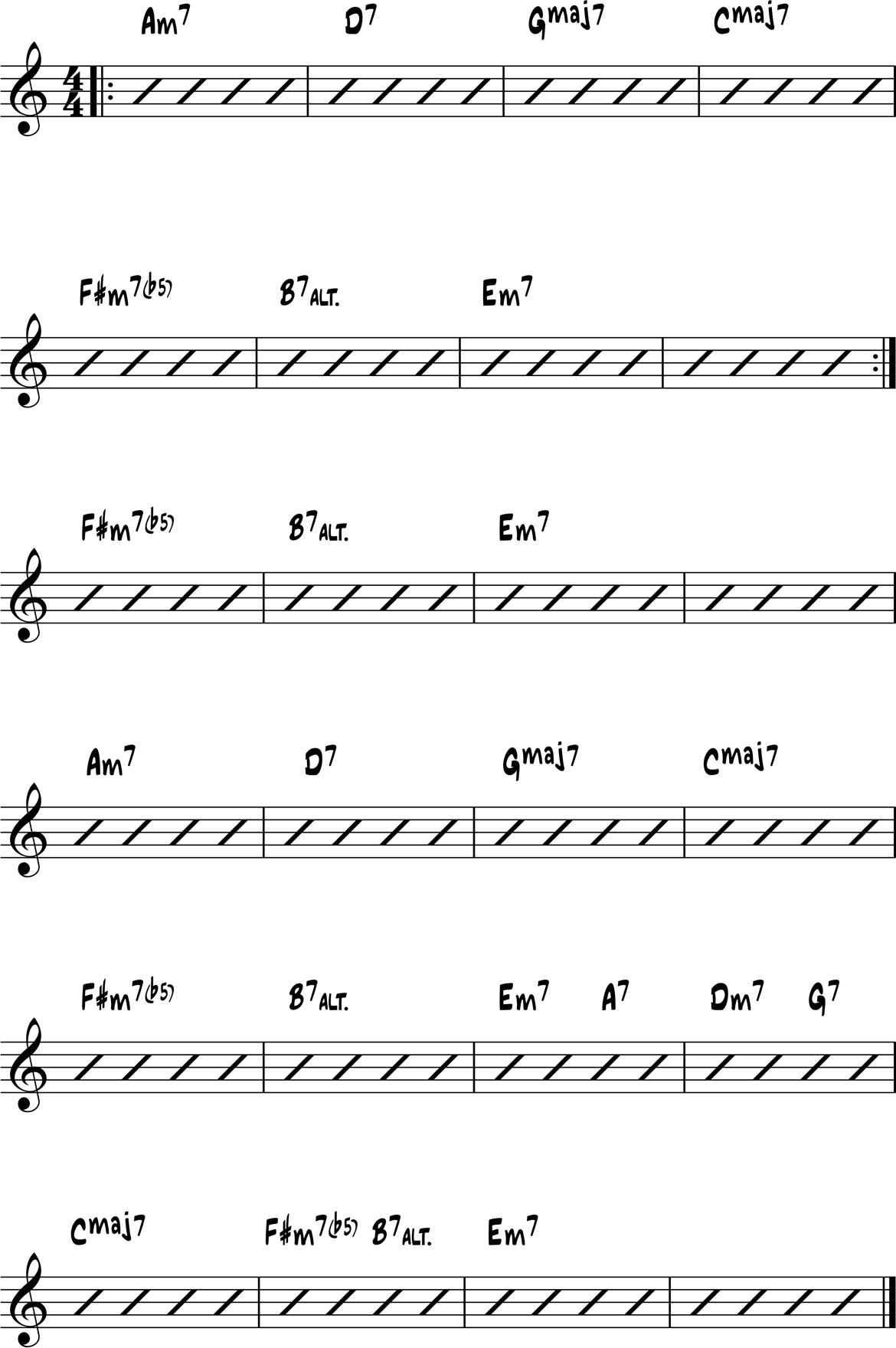How to Play Jazz Guitar Chords
Complete Beginner’s Guide
Jazz chords and comping are essential tools for anyone learning to play jazz guitar to have under their fingers.
These chords and the skill of jazz comping can also be mysterious and confusing to beginning jazz guitarists.
There seems to be a never-ending list of chords to learn before you can even get started with jazz guitar comping.
This can cause practice room stress and frustration, two roadblocks nobody wants when learning jazz guitar.
While the mountain ahead of you seems tall and steep, this doesn’t have to be the case.
With the right practice routine, an understanding of how jazz chords function, and essential shapes, you can comp over jazz standards with confidence.
In this in-depth guide, you learn how to practice, play, break down, and apply chords to essential jazz chord progressions.
By studying this material, you build your jazz chord vocabulary and confidence in no time, including essential rhythms and chromatic ornaments.
So, grab your guitar, crank up your amp, and get ready to demystify the world of jazz guitar chords and comping.
Shell Chords
The first set of chords you learn in this lesson are shell chords, built with the root, 3rd, and 7th of each chord with a few exceptions, such as 6 chords.
These three notes tell you the root of the chord, whether it’s major or minor, and if it’s a maj7, m7, 7, etc. chord.
That’s a lot of information that you can convey in your comping with a small and relatively easy chord shape.
This makes shell chords essential learning for anyone exploring jazz guitar.
Shell chords are played with root notes on the 6th and 5th strings in a traditional context, while more modern players experiment with higher string sets as well.
When playing shell chords, some shapes have a string skip while other shapes use consecutive strings.
Because of this, you can pluck, strum, or hybrid pick these chords in your playing.
If you strum these shapes, make sure to mute any skipped strings to avoid unwanted open strings from ringing over your chords.
Here are examples of shell chords to get you started.
Play through both string sets to get an idea of how these chords sound, how they sit on the fretboard, and the intervals used in each shape.
Take these shapes into a few keys and move them around the fretboard to give your ears and hands a full introduction to these chord shapes.
When ready, move on to the major and minor ii V I exercises below as you take these shell chords to must-know jazz progressions in your playing.
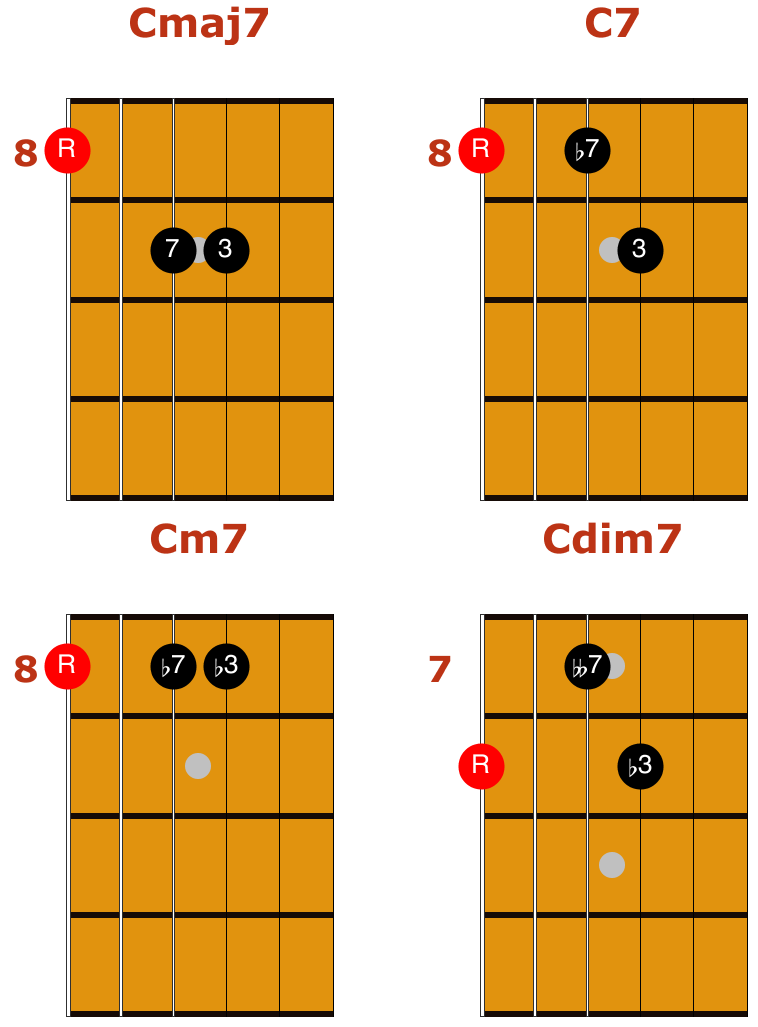
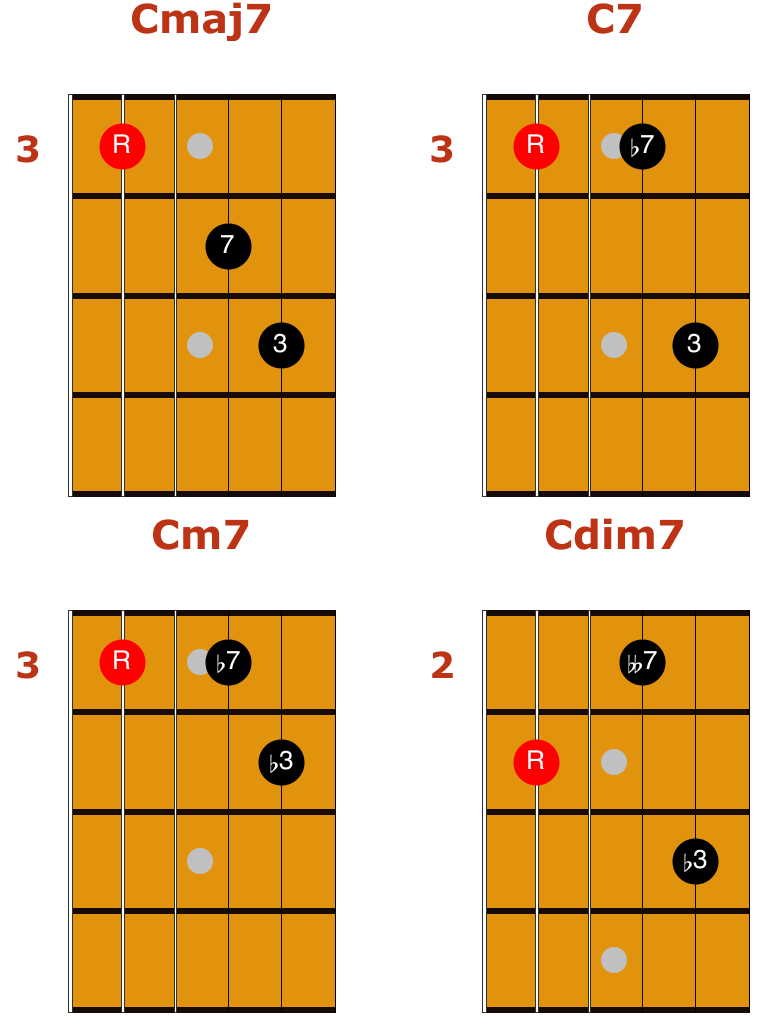
Major ii V I Shell Chords
Now that you know how to build and play a few shell chords, time to expand your vocabulary as you learn major ii V I shell chords on guitar.
Here are examples of major ii V I’s using shell chords in two positions on the fretboard.
As you work on these chords, notice that the C6 chord is included for variety in each progression.
When comping over maj7 chords, the 6 is a common choice when you want to add colors to your comping beyond the maj7 shape.
Here are tips on how to learn these chords to help get you started.
- Focus on one position of the chords at a time.
- Memorize each chord shape as soon as you can.
- Play Dm7-G7-Cmaj7-C6 all in a row over a metronome.
- Stick to an easy rhythm to begin, whole notes or Freddie Green, etc.
- Add in more complex rhythms and picking patterns when ready.
- After you learn about chromatic ornaments, add those to these shapes.
- Work the chords over the backing track.
- Sing the top note of each chord as you play it.
- Practice these chords in other keys, all 12 if possible.
Now that you know how to practice these shell chord shapes, time to get them onto the guitar and the backing track.
Shell Chords 1 Mp3
C 251 Backing Track

Shell Chords 2 Mp3
C 251 Backing Track
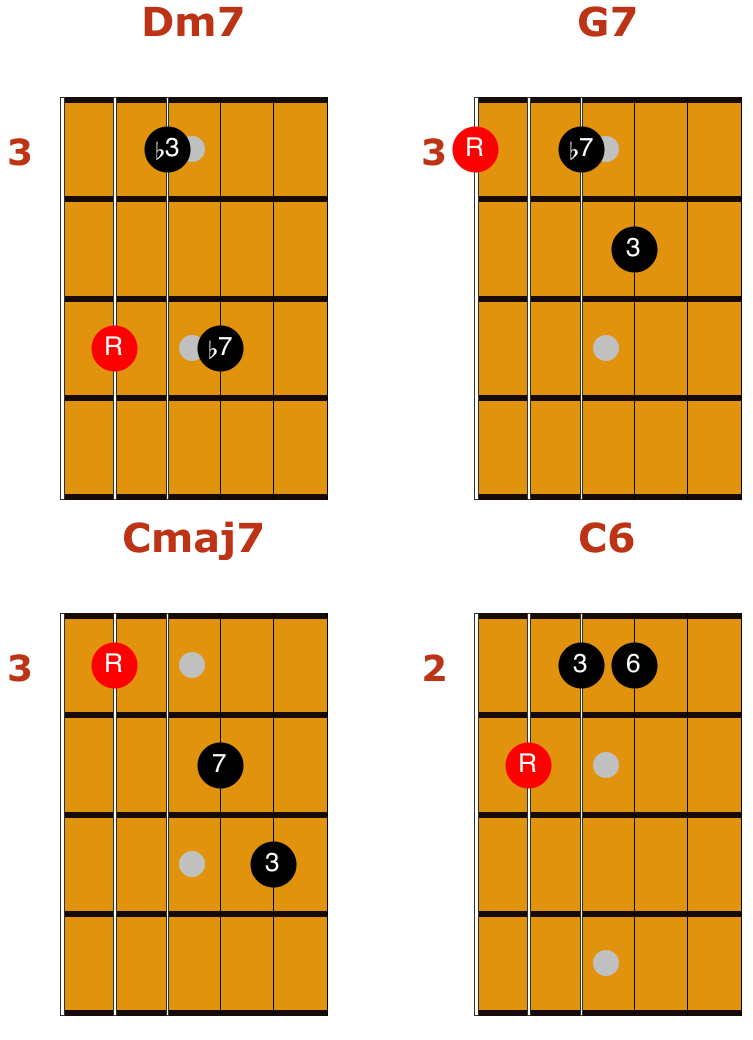
Minor ii V I Shell Chords
You’re now ready to explore the minor ii-V-I progression as you expand your shell chord vocabulary.
Here are examples of minor ii V I’s using shell chords in two positions on the fretboard.
As you work on these chords, notice that Gm6 chord is included in each progression.
When comping over Im7 chords, the m6 is a solid choice when you want to add different colors to your comping beyond the m7 sound.
Here are tips on how to learn these chords in the practice room to help get you started.
- Focus on one position of these chords at a time.
- Memorize each chord shape as soon as you learn it.
- When ready, play Am7b5-D7alt-Gm7-Gm6 over a metronome.
- Stick to an easy rhythm to begin, like Freddie Green, etc.
- Add in different rhythms and picking patterns when ready.
- Add chromatic chords, approach chords etc., to these shapes.
- Work the chords over the backing track.
- Sing the top note of each chord as you play it.
- Practice these chords in 12 keys if possible.
Now that you know how to practice these shell chord shapes, time to get them onto the fretboard and over the backing track in your workout.
Shell Chords 3 Mp3
Am 251 Backing Track
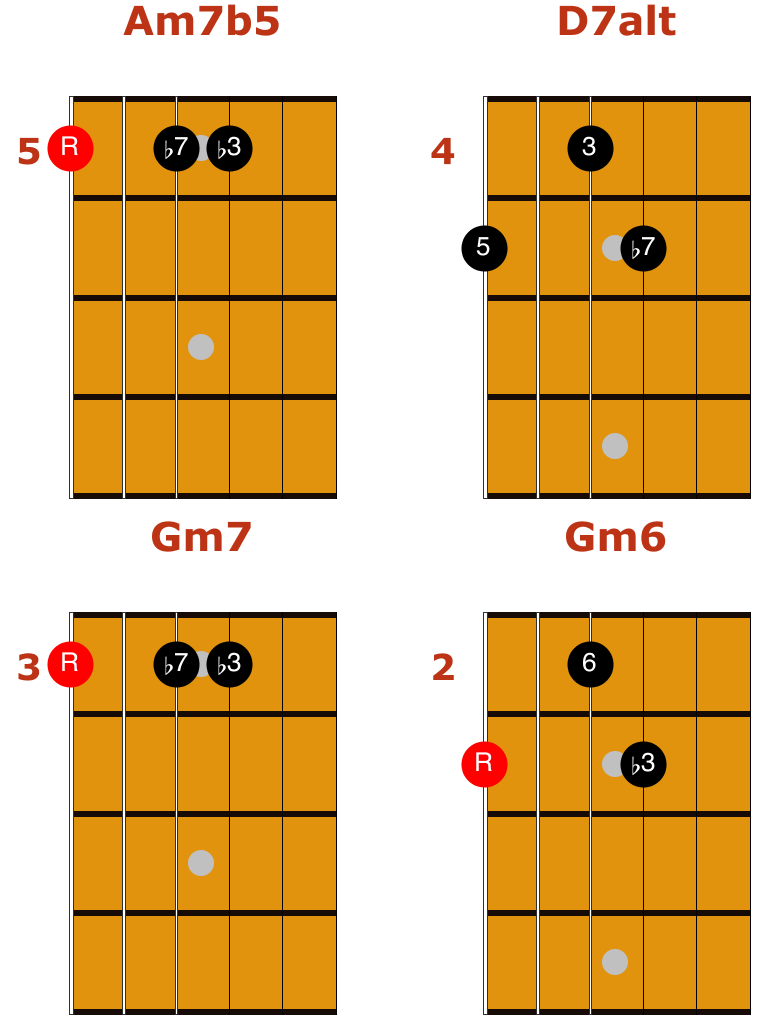
Shell Chords 4 Mp3
Am 251 Backing Track
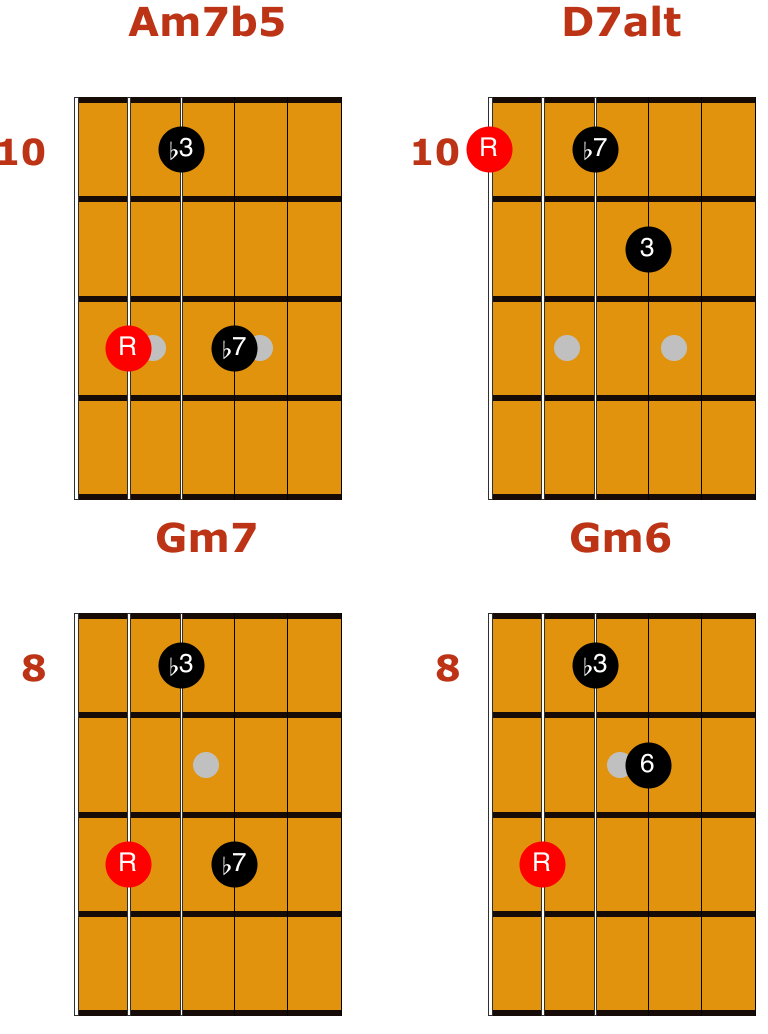
Freddie Green Rhythm
As well as learning chords in this lesson, you also add new rhythms to your jazz comping vocabulary.
The first groove you learn is the Freddie Green rhythm, named after the legendary rhythm guitarist from Count Basie’s band.
When playing this steady quarter-note rhythm, start by playing every chord with the same volume.
Then, to add an extra level of swing to this pattern, play the chords on beats 2 and 4 of each bar a little louder.
These accents get that classic Freddie Green swing feel into your comping when using this rhythm.
Start by learning this example and then take this rhythm to other chords, keys, and progressions from there.
As well, use this rhythm in any of the creative challenges in this lesson in order to apply it to full jazz standards in your studies.
Freddie Green Mp3
C 1625 Backing Track
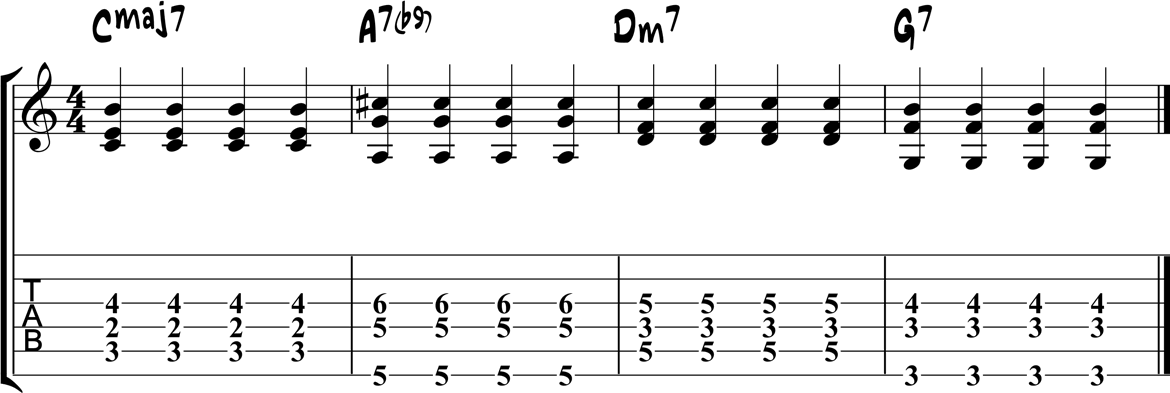
Approach Chords
The first chromatic ornament you learn and apply to your jazz comping is called the approach chord.
Chromatic ornaments are used to create tension and release in your comping and are essential for bringing a jazz sound to your rhythm guitar work.
Approach chords are played one fret below or one fret above any target chord in your comping.
So, if you want to target Dm7, you play C#m7-Dm7 or Ebm7-D#m7 to add an approach chord to your playing.
Notice that the approach chords are the same quality as the target chord, above they’re all m7 chords.
This is the same for any chord quality when adding in approach chords.
So, if your target chord is G7, you play F#7-G7 or Ab7-G7, all 7th chords as you target the G7 with approach notes.
Here’s an example to get you started with this chromatic ornament.
After you can play this example, take this concept to other keys, other chords, other progressions, and the creative challenge at the end of this chapter.
Approach Chords Mp3
C 1625 Backing Track

Creative Challenge – Summertime
You now challenge your shell chord skills as you apply the knowledge you’ve gained in this chapter to the jazz standard Summertime.
This creative challenge resembles a typical jazz lead sheet, where you’re given basic chords, slashes, and the form, then the rest is up to you.
Because you have a lot of freedom here to experiment, as long as you outline the chords, go for it.
Have fun, experiment, take tons of chances, make mistakes, and then learn from those mistakes as you go forward.
Here are tips to get the most out of this creative challenge in your practice routine.
- Pick 1 shell shape to use for each chord change in the tune.
- Stick to a Freddie Green rhythm to begin, very slow tempo.
- Add in a metronome when ready.
- Experiment with different rhythms.
- Play over the backing track.
- Experiment with chromatic ornaments like approach chords etc.
- Listen to the soloist and react to their rhythms and notes.
- Experiment with comping behind the solo vs. in between the lines.
- Have fun!
Now that you know how to practice this creative challenge, time to take it to the woodshed and get it on the fretboard.
Summertime Backing Track

Guide Tones
The next set of jazz guitar chords are small, very effective shapes called guide tones.
Guide tones are similar to shell voicings but with the root note removed.
This means that guide tones are built with the 3rd and 7th, with the major 6 exception, over any chord you’re playing.
These small shapes are highly effective when jamming with a bassist, another guitarist, or a pianist.
They allow you to state the chords, keep out of the way of the bassist, and let a pianist play bigger, more colorful chords, as they’re known to do.
To get you started, here are sample shapes of guide tones on different string sets.
Play through these chords before diving into the major and minor ii V I exercises below.
As well as learning guide tones as their own shapes, you can also build them by playing shell chords and dropping off the root note.
Either way, knowing where the closest root note is for these chords is helpful when transposing or playing these chords on the fly.
For example, the first Dm7 chord below doesn’t have a root note.
In order to quickly transpose that chord, you can visualize the root note on the 5th string 5th fret, the note D.
Seeing that note, but not playing it, allows you to use guide tones and know how to quickly apply them to any key at the same time.
Have fun as you explore these initial guide tone shapes before applying them to the progressions and creative challenge in this section.
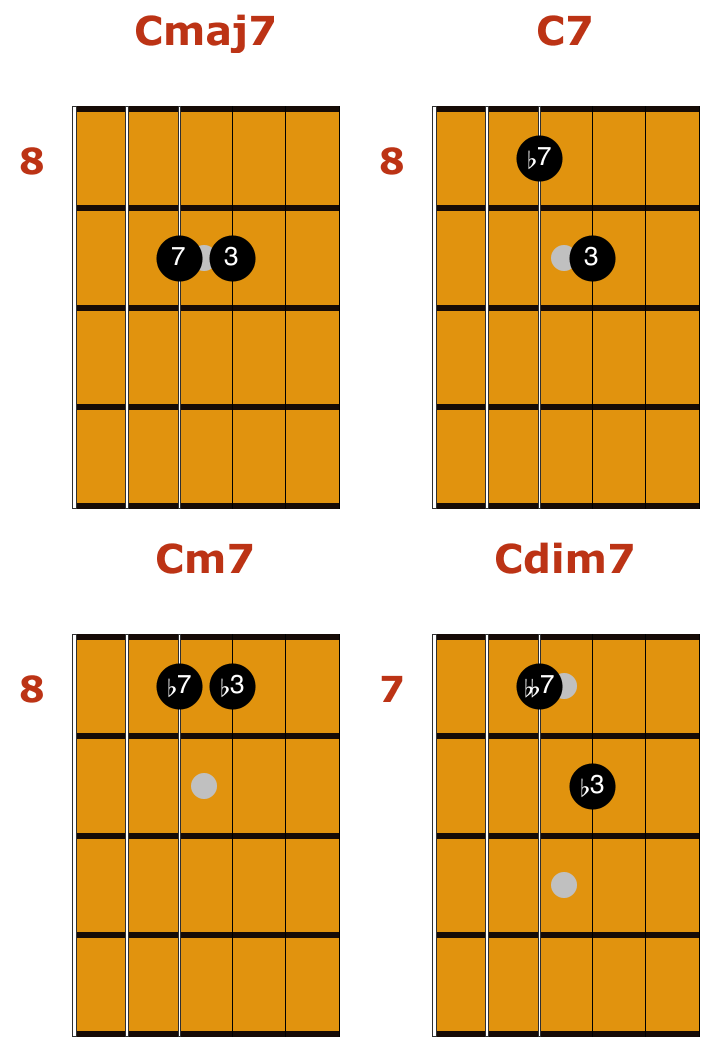
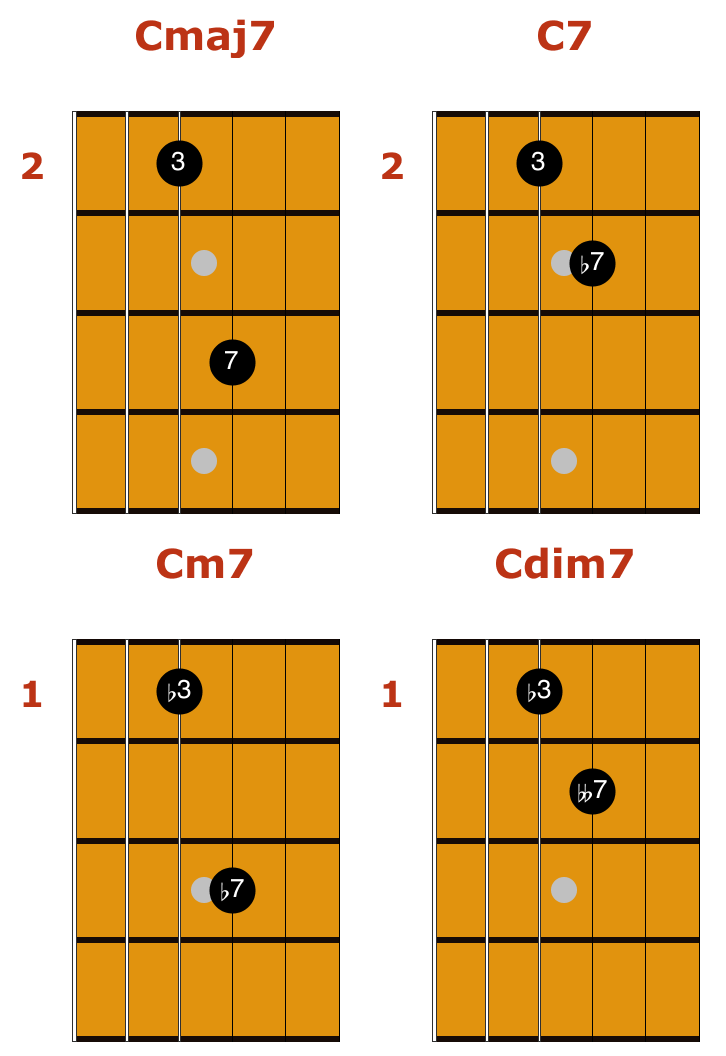
Major ii V I Guide Tones
Now that you know how to build and play a few guide tones, time to expand your vocabulary as you learn major ii V I guide tones on the fretboard.
Here are examples of major ii V I’s using guide tones on two string sets on the fretboard.
As you work on these chords, notice that the C6 chord is included in each progression.
When comping over maj7 chords, the 6 is a solid choice when you want to add different colors beyond the maj7 shape.
Here are tips on how to learn these guide tones to help get you started.
- Focus on one position of these chords at a time.
- Memorize each chord shape as soon as you learn it.
- Play Dm7-G7-Cmaj7-C6 all in a row over a metronome.
- Stick to an easy rhythm to begin, whole notes or Freddie Green, etc.
- Add in different rhythms and picking patterns when ready.
- Add chromatic chords, approach chords etc., to these shapes.
- Work the chords over the backing track.
- Sing the top note of each chord as you play it.
- Practice these chords in other keys, all 12 if possible.
Now that you know how to practice these guide tones, time to get them onto the fretboard and over the backing track in your workout.
Guide Tones 1 Mp3
C 251 Backing Track

Related MWG Courses
Guide Tones 2 Mp3
C 251 Backing Track
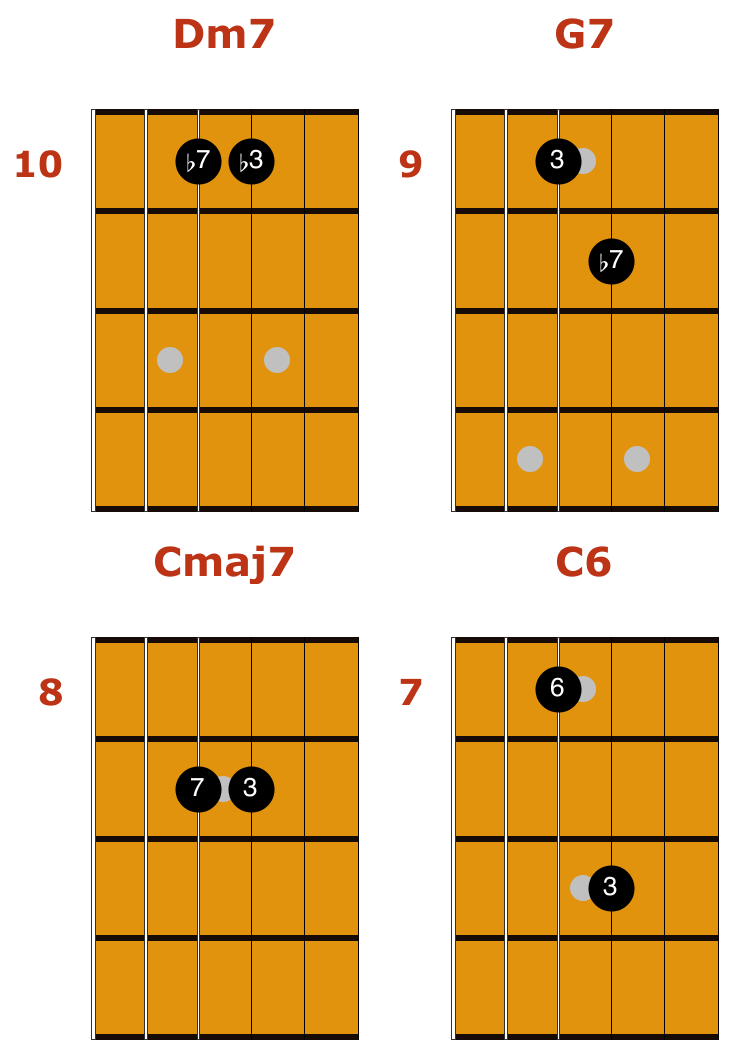
Minor ii V I Guide Tones
You’re now ready to apply guide tones to the minor ii-V-I progression as you expand your comping vocabulary.
Here are examples of minor ii V I’s using guide tones in two positions on the fretboard.
As you work on these chords, notice that the Gm6 chord is included for variety in each progression.
When comping over Im7 chords, the m6 is a solid choice when you want to spice up your m7 chords.
Here are tips on how to learn these chords in the woodshed to help get you started.
- Focus on one position of these chords at a time.
- Memorize each chord shape as soon as you learn it.
- When ready, play Am7b5-D7alt-Gm7-Gm6 all in a row over a metronome.
- Stick to an easy rhythm to begin, whole notes or Freddie Green, etc.
- Add in different rhythms and picking patterns when ready.
- Add chromatic chords, approach chords etc., to these shapes.
- Work the chords over the backing track.
- Sing the top note of each chord as you play it.
- Practice these chords in other keys, all 12 if possible.
Now that you know how to practice these guide tones, time to get them onto the fretboard and over the backing track in your workout.
Guide Tones 3 Mp3
Am 251 Backing Track
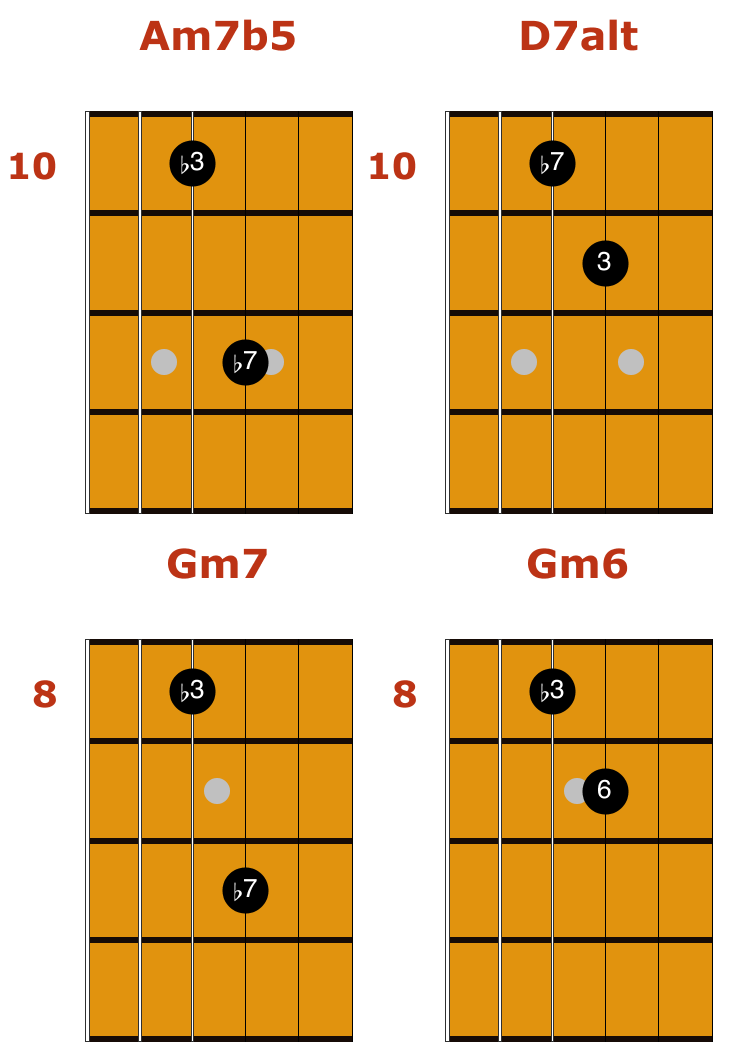
Guide Tones 4 Mp3
Am 251 Backing Track

Charleston Rhythm
You now add a new rhythm to your jazz comping toolset as you explore the Charleston rhythm.
With this rhythm, you play one chord on beat 1 of each bar followed by a chord on the & of 2 in each bar.
Counting out loud as you learn and practice this rhythm helps to speed up the learning process with this groove.
Here’s an example of the Charleston rhythm to get you started.
Once you can play this rhythm over the given chords, take it to other chords and progressions to expand on it in your studies.
From there, add this rhythm to the creative challenge at the end of this chapter and to other tunes you jam over going forward.
Have fun with this essential jazz rhythm in your studies.
Charleston Rhythm Mp3
Am 251 Backing Track
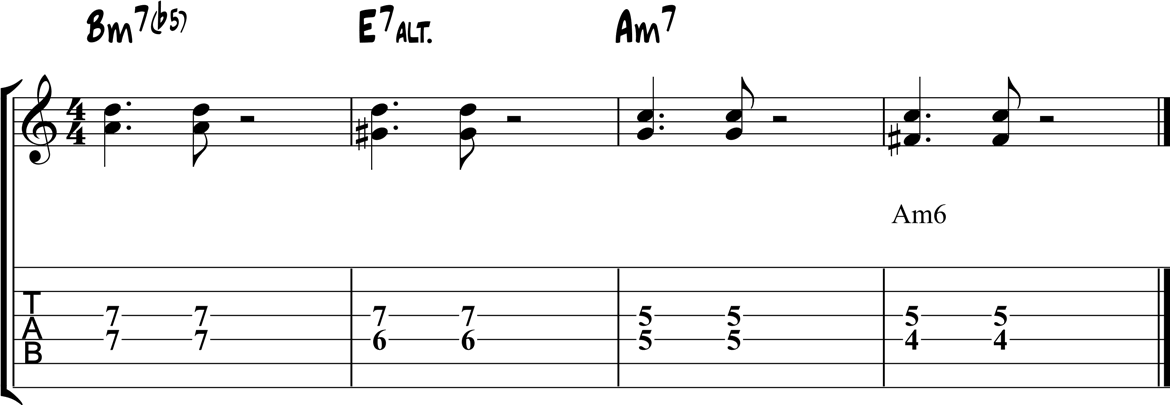
Double Approach Chords
The next chromatic ornament that you learn builds on the previous chapter, as you now add two chromatic approach chords to your target chords.
Here, when you have a target chord such as Dm7, you play Cm7-C#m7-Dm7 or Em7-Ebm7-Dm7 to create tension and release in your comping.
As was the case with approach chords, you use the same chord quality when applying double approach chords to your comping.
For example, if you target G7, you play F7-F#7-G7 or A7-Ab7-G7, all 7th chords as your target chord is a dominant shape.
To get you started, here’s an example to learn and play in this and other keys on the fretboard.
When comfortable, apply double approach chords to other chord shapes, other progressions, and then add it to the creative challenge in this chapter.
Have fun as you expand your jazz rhythm guitar vocabulary with double approach chords.
Double Approach Chords Mp3
Am 251 Backing Track
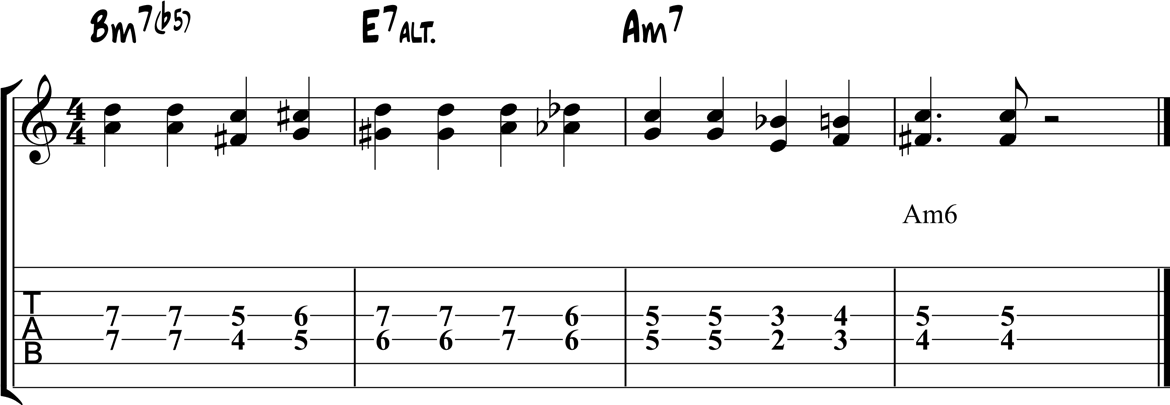
Creative Challenge – Pent Up House
You now challenge your guide tone skill set by taking the knowledge you’ve learned in this chapter and applying it to the tune Pent Up House.
This creative challenge resembles a typical jazz lead sheet, where you’re given basic chords, slashes, and the form, then the rest is up to you.
Because you have a lot of freedom here to experiment, as long as you outline the chords, go for it.
Cut loose, have fun, take tons of chances, make mistakes, and then learn from those mistakes as you go forward.
Here are tips to get the most out of this creative challenge in your playing.
- Pick 1 guide tone shape to use for each chord in the tune.
- Stick to a Freddie Green rhythm to begin, very slow tempo.
- Add in a metronome when ready.
- Experiment with different rhythms.
- Play over the backing track.
- Experiment with chromatic ornaments like approach chords etc.
- Listen to the soloist and react to their rhythms and notes.
- Experiment with comping behind the solo vs. in between the lines.
- Have fun!
Now that you know how to practice this creative challenge, time to take it to the fretboard.
Pent Up House Backing Track
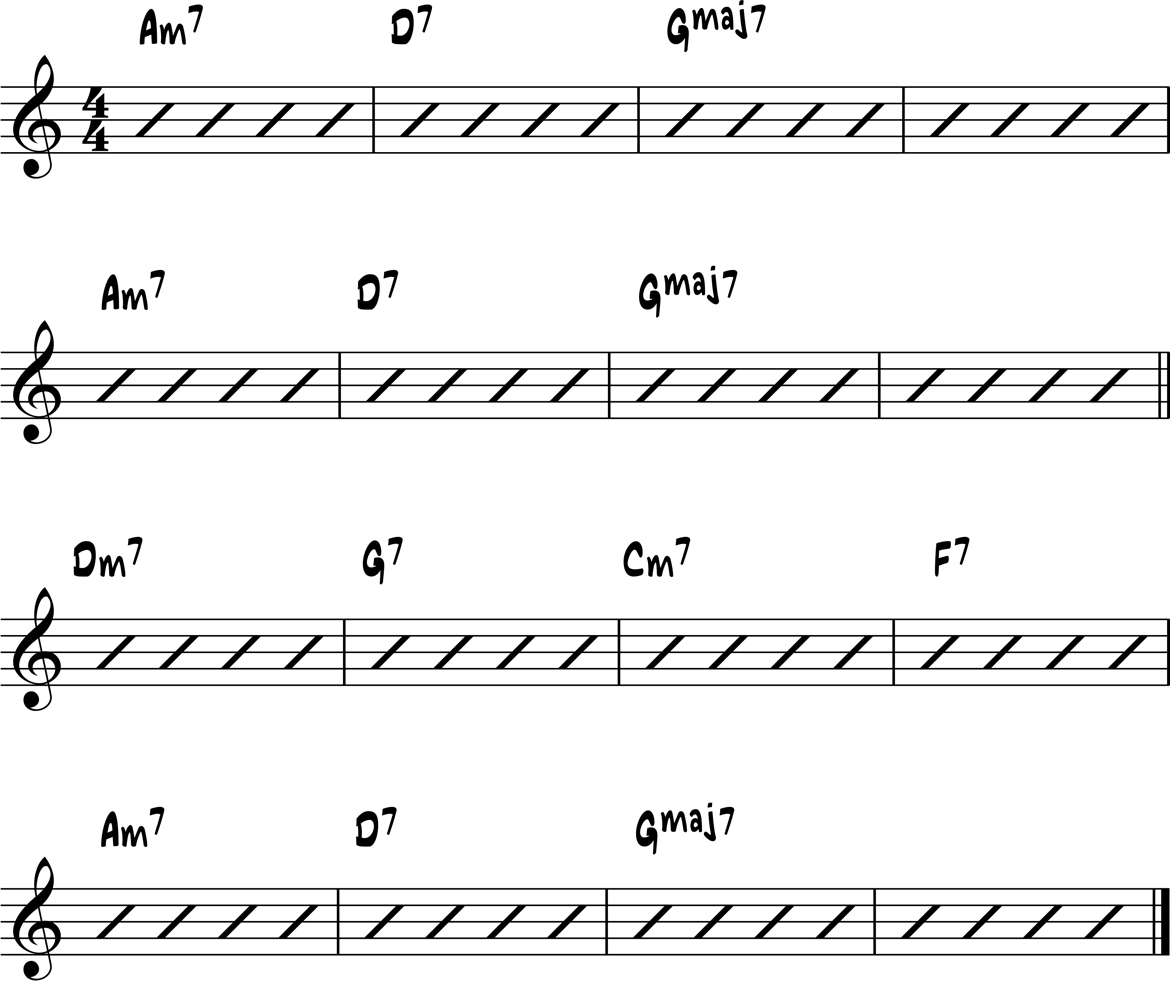
Drop 3 Chords
The next set of chords you learn about are called drop 3 chords.
The name comes from how you change a closed position chord into a drop 3 chord shape.
If you have a closed chord, 1357, and you drop the 3rd note from the top by an octave, you get an inversion of a drop 3 chord. 3157.
From there, you can derive the inversions of any drop 3 shape.
Whether or not you understand the history of the drop 3 name, you can still enjoy playing these chords over jazz standards.
So, play these chords first, and then let the theory catch up with time.
When playing any drop 3 chord shape, you have a string skip between the two lowest notes in the chord.
Because of this, if you strum these chords you need to mute that open string to avoid any unwanted notes ringing over your chords.
If you pluck or hybrid pick these chords, that open string is avoided so no worries.
To get started, here are examples of drop 3 chords on two different string sets.
Start by playing through these shapes to introduce them to your ears and fingers before diving into the progression exercises below.
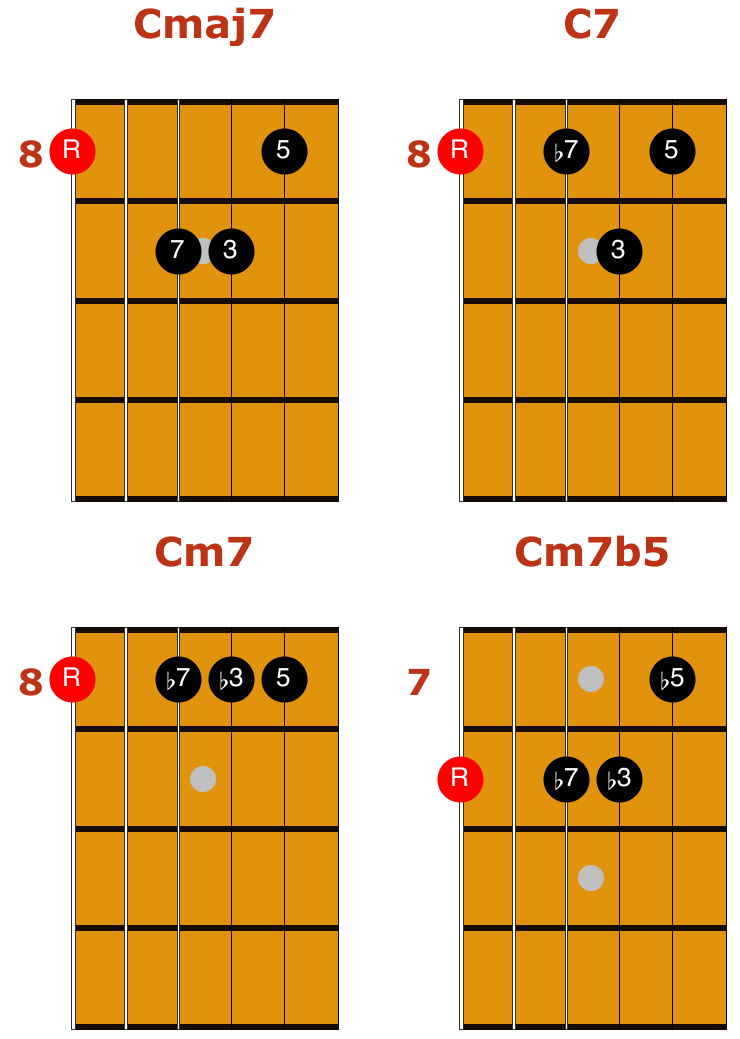

Major ii V I Drop 3 Chords
Now that you know how to build and play several drop 3 chords, time to expand your vocabulary as you learn major ii V I shapes on guitar.
Here are examples of major ii V I’s using drop 3 chords in two positions on the fretboard.
As you work on these chords, notice that the C6 chord is included for variety in each progression.
When comping over maj7 chords, the 6 is a solid choice when you want to add different colors to your comping beyond maj7.
Here are tips on how to learn these chords in the practice room to help get you started.
- Focus on one position of these drop 3 chords at a time.
- Memorize each chord shape as soon as you learn it.
- When ready, play Dm7-G7-Cmaj7-C6 all in a row over a metronome.
- Stick to an easy rhythm to begin, whole notes or Freddie Green, etc.
- Add in different rhythms and picking patterns when ready.
- Add chromatic chords, approach chords etc., to these shapes.
- Work the chords over the backing track.
- Sing the top note of each chord as you play it.
- Practice these chords in other keys, all 12 if possible.
Now that you know how to practice these drop 3 chord shapes, time to get them onto the fretboard and over the backing track in your workout.
Drop 3 1 Mp3
C 251 Backing Track
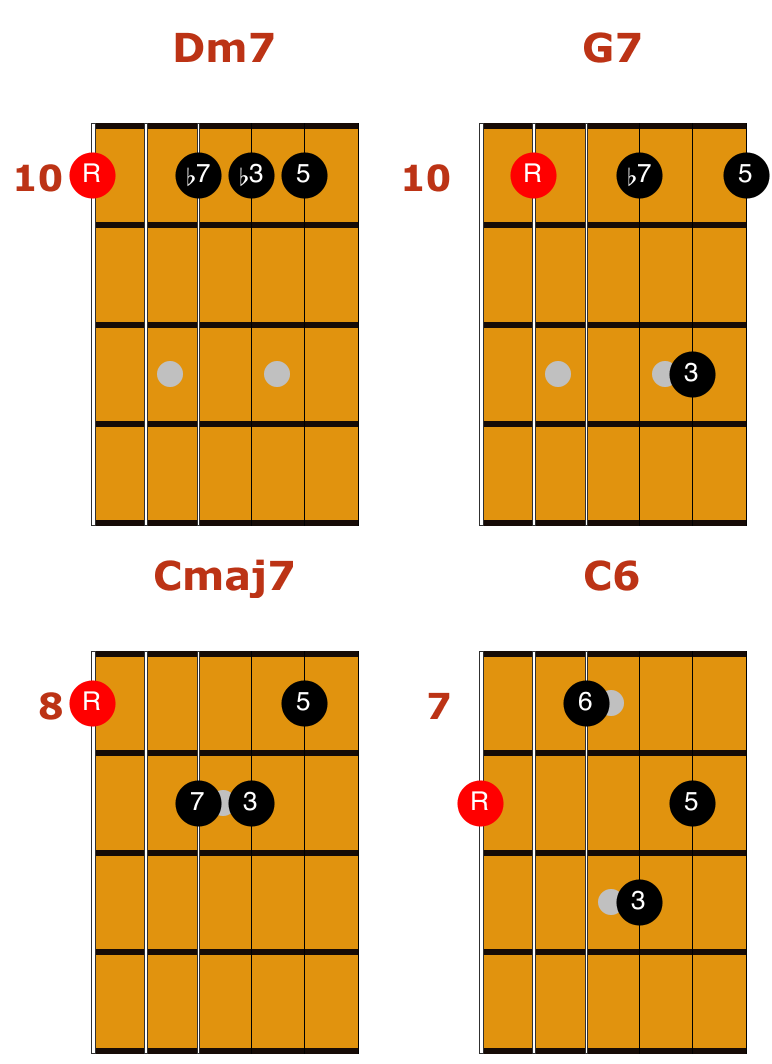
Drop 3 2 Mp3
C 251 Backing Track
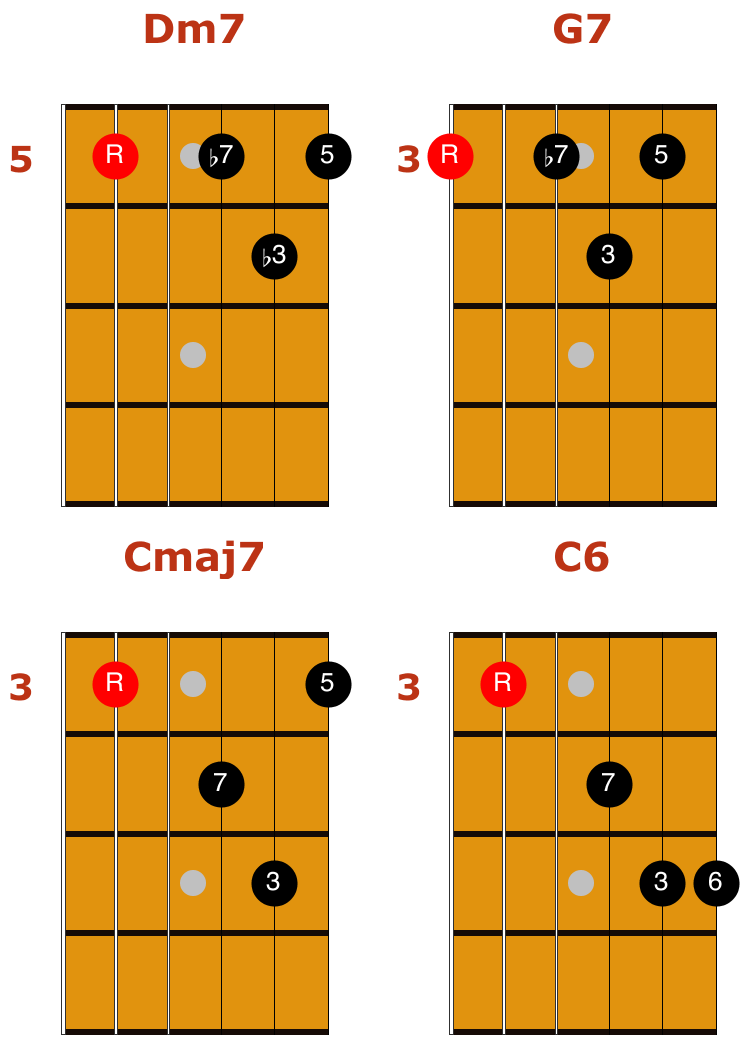
Minor ii V I Drop 3 Chords
You’re now ready to dive into the minor ii-V-I progression as you expand your drop 3 chord vocabulary in the woodshed.
Here are examples of minor ii V I’s using drop 3 chords on two string sets and positions on the fretboard.
As you work on these chords, notice that the Gm6 chord is included for variety in each progression.
When comping over Im7 chords, the m6 is a solid choice when you want to add different colors to your comping beyond m7.
Here are tips on how to learn these drop 3 chords in the practice room to help get you started.
- Focus on one position of these chords at a time.
- Memorize each chord shape as soon as you learn it.
- Play Am7b5-D7alt-Gm7-Gm6 all in a row over a metronome.
- Use an easy rhythm to begin, whole notes or Freddie Green, etc.
- Add in different rhythms and picking patterns when ready.
- Add chromatic chords, approach chords etc., to these shapes.
- Work the chords over the backing track.
- Sing the top note of each chord as you play it.
- Practice these chords in other keys, all 12 if possible.
Now that you know how to practice these chord shapes, time to get them onto the fretboard and over the backing track in your workout.
Drop 3 3 Mp3
Am 251 Backing Track
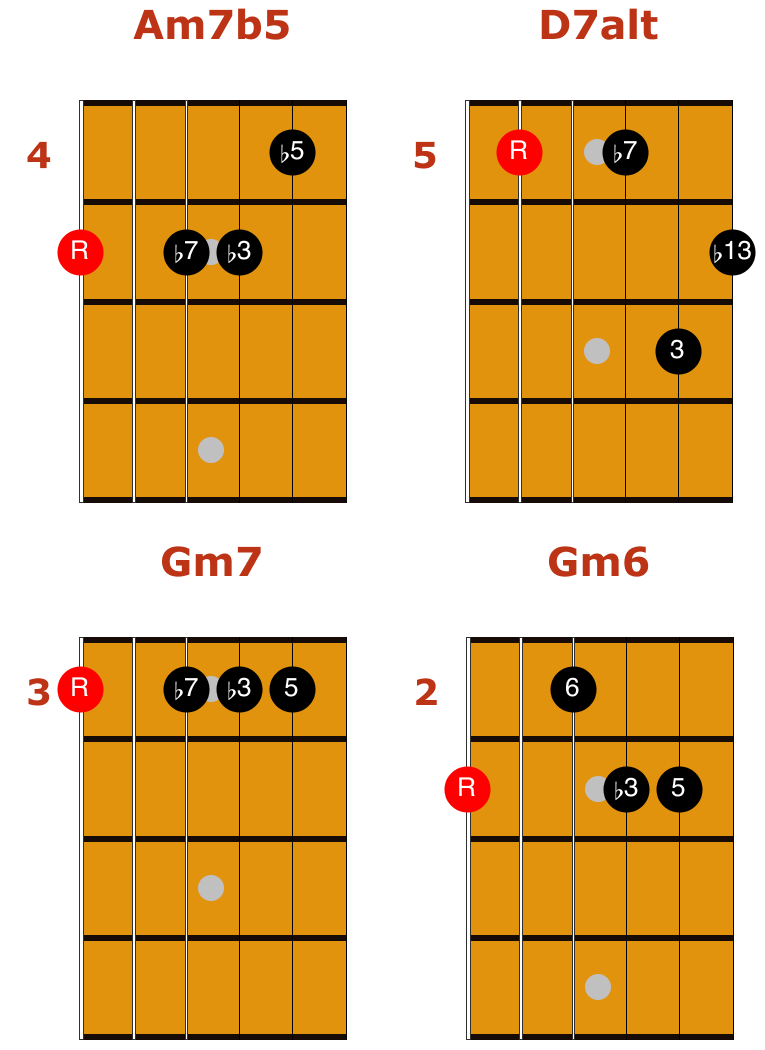
Drop 3 4 Mp3
Am 251 Backing Track
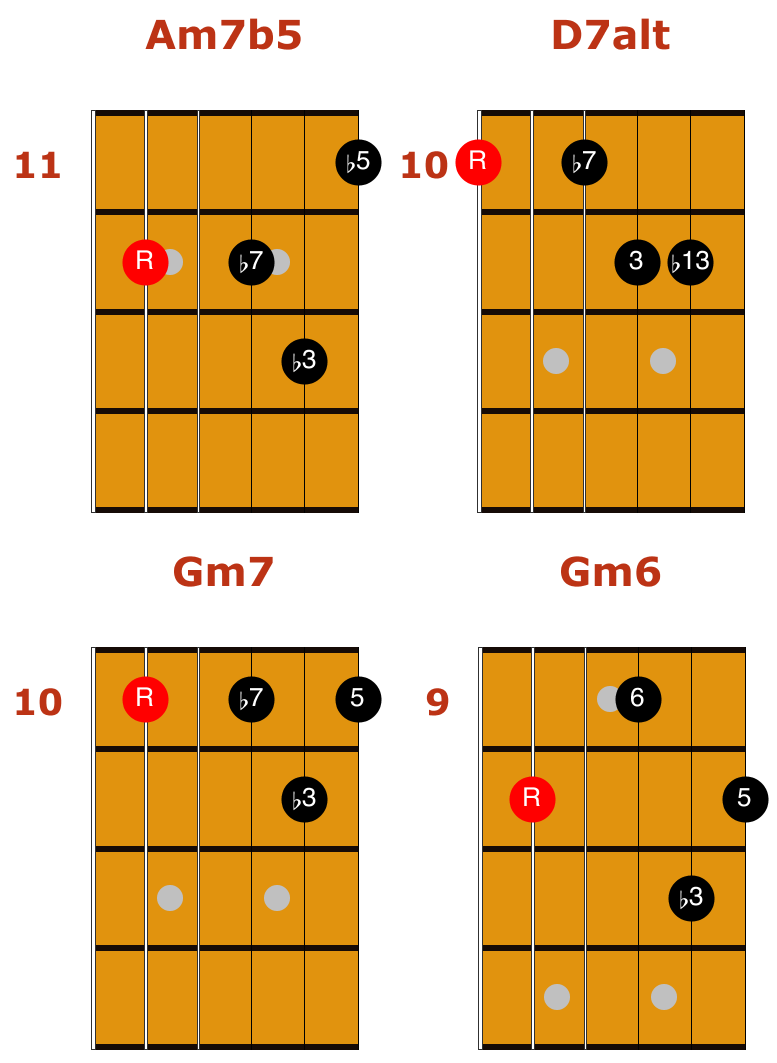
Syncopated Rhythm 1
Here’s a new rhythm to explore in your jazz guitar comping, one that uses only up beats in each bar.
This is an example of a “syncopated” rhythm, where you have more up beats than down beats in each bar. More &’s than 1234’s.
Because of this syncopated groove, counting out loud and writing out the counting to ensure accuracy is essential.
To help get you started with this rhythm, here’s an example to play and work in different keys in your studies.
Once you have this example under your fingers, take this rhythm to the creative challenge in this chapter and to other tunes in your studies.
Rhythms are like scales, chords, arpeggios, etc., in that the more you use them, the easier they become, and then less thinking needed to play them.
Have fun exploring this syncopated rhythm as you expand your comping vocabulary and skill set.
Syncopation 1 Mp3
C 1625 Backing Track

Enclosure Chords
The final chromatic ornament in this lesson is the enclosure, where you play one fret above, then one fret below, before landing on your target chord.
You can also play fret below, fret above, then your target chord.
When using enclosure chords, you always play the same chords as the target chord when creating tension.
For example, if your target chord is Dm7, you play Ebm7-C#m7-Dm7, so all m7 chords as your target chord is m7.
Because you have two tension chords here before you land on your resolution chord, enclosures can take time to sound “normal” to your ears.
To help speed up this process, use as many enclosures as you can when first working this concept in your studies.
That gets the sound of these chromatic chords into your ears, and then you can pull back and use more targeted enclosures in your playing from there.
Here’s an example of enclosure chords from above and below to get you started.
From there, work these chords in different keys and progressions, and add them to the creative challenge in this section to expand on this idea in your playing.
Enclosure Chords 1 Mp3
C 1625 Backing Track

Creative Challenge – Song for My Father
You now challenge your drop 3 skillset as you apply the knowledge you’ve learned in this chapter to the jazz standard Song for My Father.
This creative challenge resembles a typical fakebook lead sheet, where you’re given basic chords, slashes, and the form, then the rest is up to you.
Because you have a lot of freedom here to experiment, as long as you outline the chords, go for it.
Cut loose, have fun, experiment, make mistakes, and then learn from those mistakes as you go forward.
Here are tips to get the most out of this creative challenge in your playing.
- Pick 1 drop 3 chord shape to use for each chord in the tune.
- Stick to a Freddie Green rhythm to begin, very slow tempo.
- Add in a metronome when ready.
- Experiment with different rhythms.
- Play over the backing track.
- Experiment with chromatic ornaments like approach chords etc.
- Listen to the soloist and react to their rhythms and notes.
- Experiment with comping behind the solo vs. in between the lines.
- Have fun!
Now that you know how to practice this creative challenge, time to take it to the woodshed and get it on the fretboard.
Song for My Father Backing Track
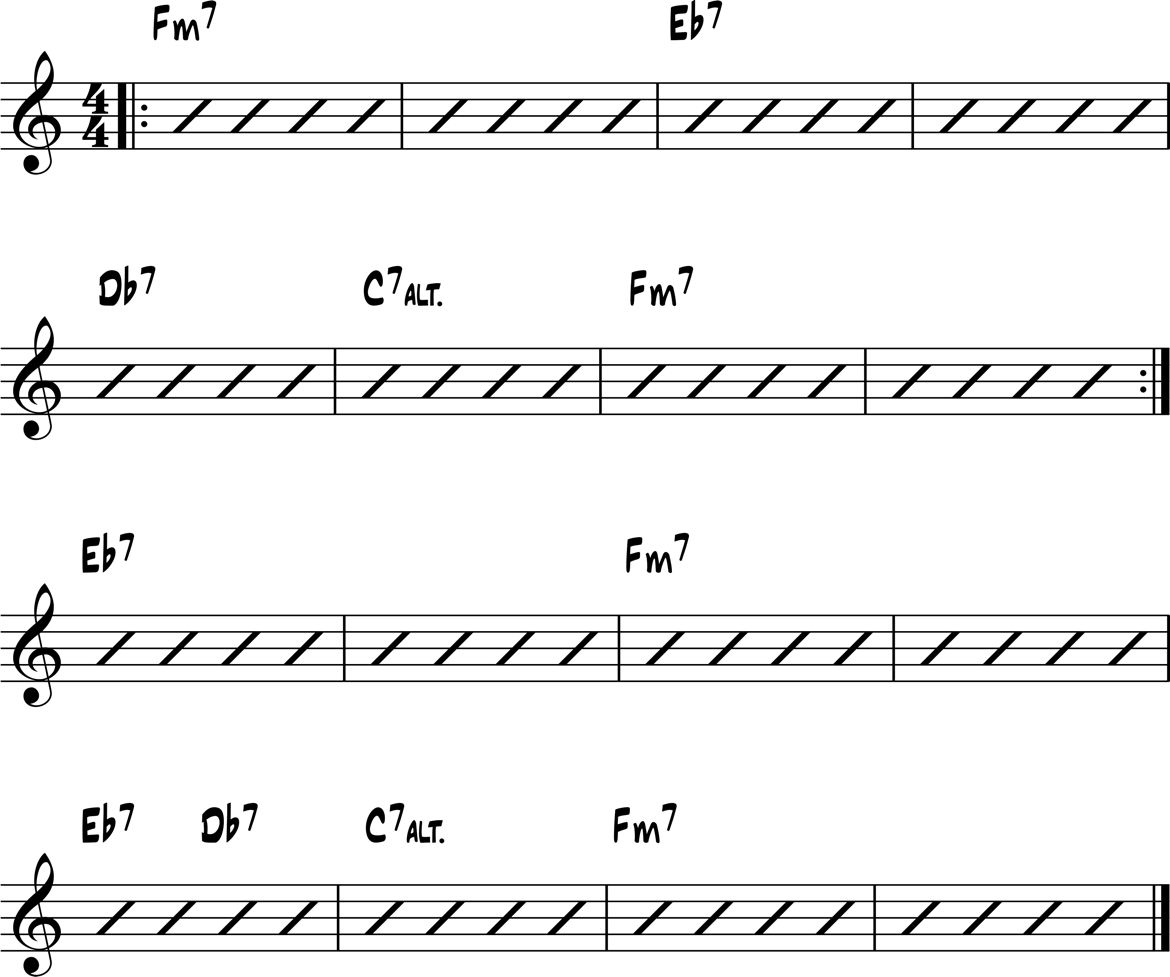
Drop 2 Chords
The final shapes you study in this intro to jazz guitar chords are called drop 2’s.
As was the case with drop 3 chords, drop 2’s are named because of how they’re built compared to closed position shapes.
If you take 1357 and lower the 2nd highest note, you get an inversion of a drop 2 chord, 5137.
Again, you don’t have to understand the origins of this chord group to play it and add it to your comping over jazz standards.
As these shapes don’t have a string skip, you can pluck them, strum them, or hybrid pick them, and not worry about open strings ringing over chords.
Start by playing the example chords below, on both string sets, to get a feel for how drop 2 chords sit on the guitar.
Then, when ready, move on to the major and minor ii V I exercises below to hear these chords in the context of a progression.
Have fun exploring these essential jazz guitar chord shapes in your studies.


Major ii V I Drop 2 Chords
Now that you know how to play several drop 2 chords, time to expand your vocabulary as you learn major ii V I drop 2 chord shapes.
Here are examples of major ii V I’s using drop 2 chords in two positions on the fretboard.
As you work on these chords, notice that the C6 chord is included for variety in each progression.
When comping over maj7 chords, the 6 is a solid choice when you want to add different colors beyond maj7.
Here are tips on how to learn these chords to help you get started.
- Focus on one position of these chords at a time.
- Memorize each chord shape as soon as you learn it.
- Play Dm7-G7-Cmaj7-C6 all in a row over a metronome.
- Use an easy rhythm to begin, whole notes or Freddie Green, etc.
- Add in different rhythms and picking patterns when ready.
- Add chromatic chords, approach chords etc., to these shapes.
- Work the chords over the backing track.
- Sing the top note of each chord as you play it.
- Practice these chords in other keys, all 12 if possible.
Now that you know how to practice these drop 2 chord shapes, time to get them onto the fretboard and over the backing track in your workout.
Drop 2 1
C 251 Backing Track

Drop 2 2
C 251 Backing Track
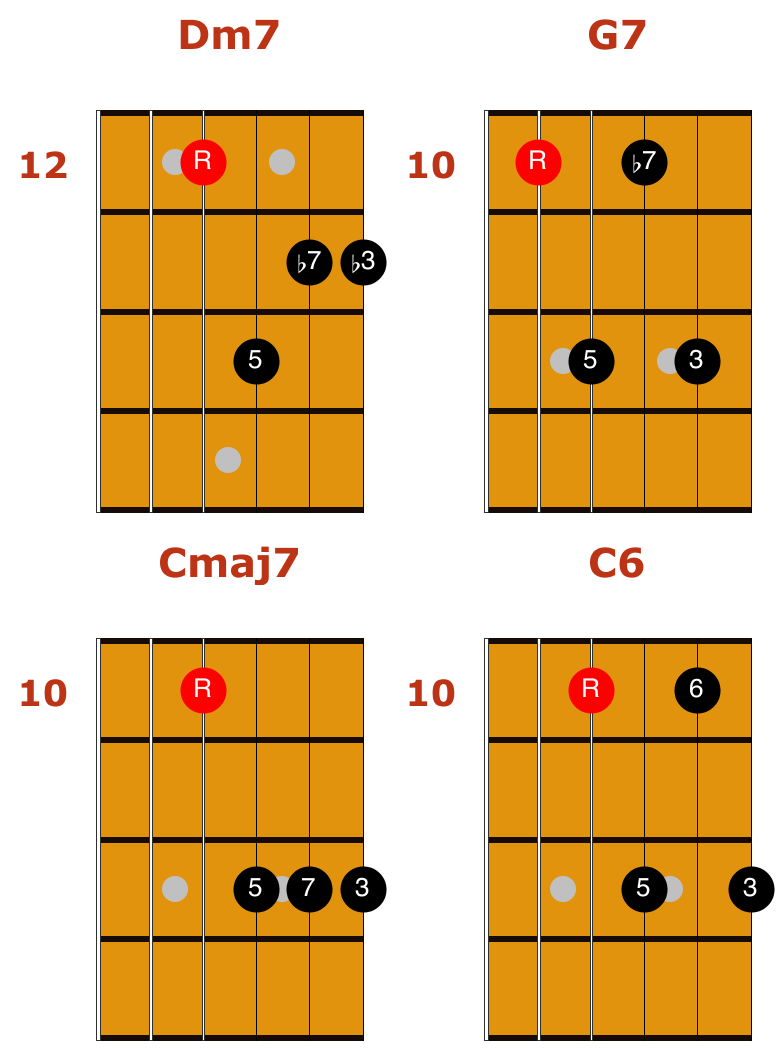
Minor ii V I Drop 2 Chords
You’re now ready to learn minor ii-V-I drop 2 chords as you expand your chord vocabulary in the woodshed.
Here are examples of minor ii V I’s using drop 2 chords on two string sets and positions on the fretboard.
As you work on these chords, notice that the Gm6 chord is included for variety in each progression.
When comping over Im7 chords, the m6 is a solid choice when you want to add different colors to your comping.
Here are tips on how to learn these drop 2 chords in the practice room to help get you started.
- Focus on one position of these chords at a time.
- Memorize each chord shape as soon as you learn it.
- Play Am7b5-D7alt-Gm7-Gm6 all in a row over a metronome.
- Stick to an easy rhythm to begin, whole notes or Freddie Green, etc.
- Add different rhythms and picking patterns when ready.
- Add chromatic chords, approach chords etc., to these shapes.
- Work the chords over the backing track.
- Sing the top note of each chord as you play it.
- Practice these chords in other keys, all 12 if possible.
Now that you know how to practice these chord shapes, time to get them onto the fretboard and over the backing track in your workout.
Drop 2 3 Mp3
Am 251 Backing Track

Drop 2 4 Mp3
Am 251 Backing Track

Syncopated Rhythm 2
You now add a new rhythm to your comping vocabulary as you explore a syncopated groove where chords land on the & of 2 and 4 in each bar.
Because there are no down beats in this rhythm, counting along or writing out the counting is essential to be accurate with these 8th notes.
As well, notice that the chord that lands on the & of 4 are the chord from the next bar, not the bar you’re on.
This is called “anticipation,” as you anticipate the next chord change by half a beat in your comping.
This is tough to do at first, so play along with the audio example until you get it, then take it to the backing track from there.
Here’s an example of this rhythm to get you started.
Take this rhythm to the creative challenge in this chapter and beyond as you add it to your playing.
Syncopation 2 Mp3
C 1625 Backing Track

Picking Pattern
In place of a chromatic ornament, in this chapter, you learn about a common jazz picking pattern that brings out the melody note of any chord shape.
When playing rhythm guitar in a non-jazz genre, you mostly focus on the root or lowest note of any chord shape you play.
This is because many chords have the root on the 6th or 5th strings, and as guitarists, we see those notes first when we look down at the fretboard.
But, other people, such as the audience or our bandmates, hear the top note of the chord as the most important, not the bass note.
This is especially true if there’s a bassist playing the root and lower notes underneath our chords.
Lastly, this pattern is helpful when you begin to explore chord melody and chord soloing. where the melody note is the essential note of any chord shape.
To get you started with this picking pattern, here’s an example of this picking over a minor ii-V-I progression.
After you can play this example, take it to other keys, other chord shapes, other progressions, and when ready, to the creative challenge in this chapter.
Picking Patterns Mp3
Am 251 Backing Track

Creative Challenge – Sunny
You now challenge your drop 2 skillset as you take the knowledge you’ve learned in this chapter and apply it to the song Sunny.
This creative challenge resembles a jazz lead sheet, where you’re given basic chords, slashes, and the form, then the rest is up to you.
Because you have a lot of freedom here to experiment, as long as you outline the chords, go for it.
Cut loose, have fun, experiment, take tons of chances, make mistakes, and then learn from those mistakes as you go forward.
Here are tips to get the most out of this creative challenge in your playing.
- Pick 1 drop 2 chord shape to use for each chord in the tune.
- Stick to a Freddie Green rhythm to begin, very slow tempo.
- Add in a metronome when ready.
- Experiment with different rhythms.
- Play over the backing track.
- Experiment with chromatic ornaments like approach chords etc.
- Listen to the soloist and react to their rhythms and notes.
- Experiment with comping behind the solo vs. in between the lines.
- Have fun!
Now that you know how to practice this creative challenge, time to take it to the woodshed and get it on the fretboard.
Sunny Backing Track Mp3
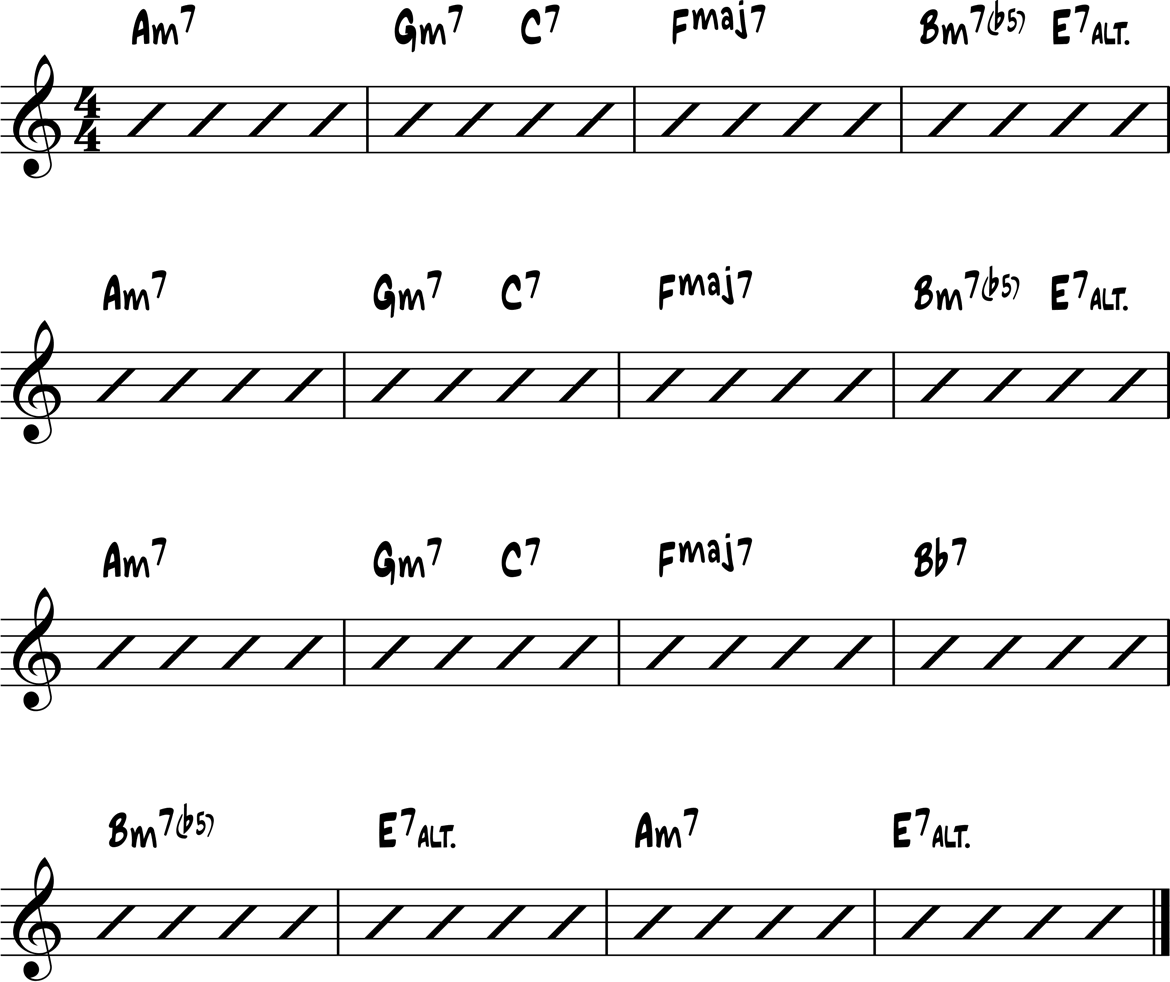
Jazz Chords Technical Study
To test your jazz guitar chord skill set, here’s a technical study that uses specific shapes, rhythms, and ornaments over a Blues in G.
Begin by playing through the chords, no rhythms, and then count or write out the rhythm before adding it to the chords.
Use a metronome, start nice and slow, and build the tempo up over time.
From there, play along with the audio example and then the backing track to get the most out of this study in the woodshed.
To help you get these chords and rhythms under your fingers, here are tips to check out as you work through this study.
- Learn the study one bar at a time, memorize each bar.
- Work up to 2, then 4, then all 12 bars together.
- Work no tempo at first.
- Add in a metronome when ready.
- Play over the audio example then backing track when ready.
- Add in variations to the study, chords, rhythms, picking, etc.
- Write out your own study over a blues in a similar fashion.
Now that you know how to practice this chord study, time to take it to the fretboard.
G Blues Backing Track Mp3
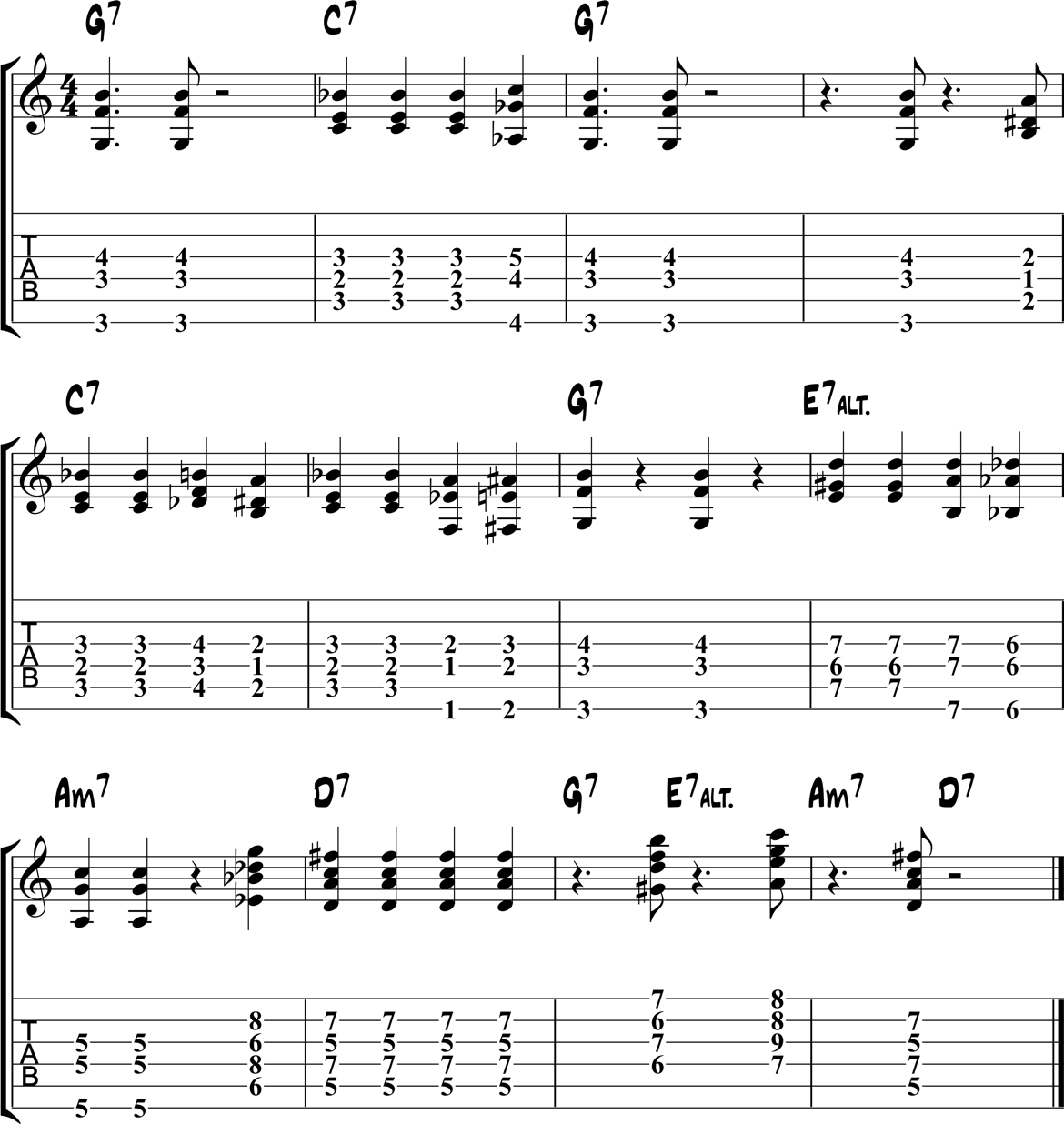
Jazz Chords Creative Challenge
To finish up your intro to jazz guitar chords, you apply the skills you gained in this lesson to the jazz standard Autumn Leaves.
With this creative challenge, all you’re given are the chord changes, form, and slashes for rhythms.
It’s up to you to take this lead sheet and turn it into a comping performance.
Here are tips and goals to work on as you dig into this creative study in your practice routine.
- Find one chord shape for each chord in the tune to use.
- Play those chords without rhythm in the order on the sheet.
- Play your chosen chords with the Freddie Green rhythm.
- Add a metronome when ready.
- Add in different rhythms and picking patterns.
- Bring those chords and rhythms to the backing track.
- Add in chromatic chords to the mix, approach chords etc.
- Listen to the soloist and fit your chords into their lines and spaces.
- Have fun!
Now that you know how to tackle this challenge, time to grab your guitar and get these chords on the fretboard!
Note: Make sure to take the repeat signs in bars 1-8 in order to play the form correctly. Here, you play bars 1-8, then repeat those bars, then go on from there.
Autumn Leaves Backing Track Mp3
